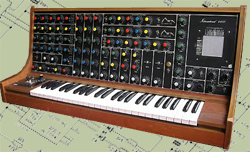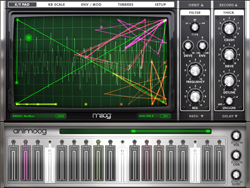![]() Before I discovered the secret world of the recording studio, it was the mystery and promise of early commercial synthesisers that occupied the less engaging moments of my education.
Before I discovered the secret world of the recording studio, it was the mystery and promise of early commercial synthesisers that occupied the less engaging moments of my education.
That was in the day when you could build a synthesiser on a kitchen table – something with not inconsiderable appeal. And before ICs ruined everything. Now those days are poised to make a comeback...
Having doodled an oscillator circuit on the back of my music exercise book in an abstracted moment, it seemed the right schoolboy thing to finish the job and build it. On the cover, obviously.
It worked fine – after a fashion – and I contemplated building a functioning synth. With hindsight, I admit that I was never going to give Bob Moog or Alan Pearlman a run for their money. But worse, technology was about to undergo a generational change that school book covers and kitchen tables would be woefully unable to support.
 With ICs, especially large-scale custom ICs, the likes of Yamaha and Roland beamed down instruments from another world. The eighties appetite for FM, additive and hybrid synthesis was voracious. Analogue was suddenly too familiar. Digital was a razor-edged revelation. Home cooking, it seemed, suddenly wasn’t tasty enough.
With ICs, especially large-scale custom ICs, the likes of Yamaha and Roland beamed down instruments from another world. The eighties appetite for FM, additive and hybrid synthesis was voracious. Analogue was suddenly too familiar. Digital was a razor-edged revelation. Home cooking, it seemed, suddenly wasn’t tasty enough.
Even the analogue renaissance brought to the mainstream by dance music wasn’t enough to revive homebuilds. Midi sequencing and digital recording made room for Midi/CV converters and specialist Midi ‘retrofitting’ by people able to hack digital synth circuitry, but little more. (I converted my Minimoog to accept CV as well as S-Trig myself but I had call on Kenton Electronics to bring Midi to my Jupiter 8) In the meantime, the only guys keeping their soldering irons warm were guitarists signing up for the BYOC (build you own clone) club.
If anything, the successor to kitchen synth building was bedroom computer programming. The virtual world – accesssed through newly affordable computers – welcomed a new generation with an old agenda. It also brought us computer hackers. Same attitude, different ethic.
Fast forward and the hands-on, hacker and hardware worlds are ready to re-engage. Enter hard hacking.
Return to the breadboard. Come and have a go...
The technology that has appeared in the wake of the pioneering days of analogue synthesisers is staggering. But it has come at a cost. The beauty of circuitry based on a collection of resistors, capacitors and transistors – discrete components – was that it not only allowed engineers of limited means to build pioneering kit but that it also allowed them to understand circuits designed and built by others. The rise of LSI, VLSI and custom chips locked them out on both fronts. Further disenfranchising ‘analogue hackers’, some manufacturers removed names and numbers from commercially available chips. They were off the menu.
 The head chef in the new kitchen of homebrew electronics is an Italian. His name is Arduino. And he’s a ‘hard friend’ to those who might want to create their own instruments, equipment and toys. He is young and spirited but he’d be no stranger to an old school breadboard.
The head chef in the new kitchen of homebrew electronics is an Italian. His name is Arduino. And he’s a ‘hard friend’ to those who might want to create their own instruments, equipment and toys. He is young and spirited but he’d be no stranger to an old school breadboard.
In the words of its Italian manufacturer, Arduino is ‘an open-source electronics prototyping platform based on flexible, easy-to-use hardware and software’ intended for ‘artists, designers, hobbyists and anyone interested in creating interactive objects or environments’. This is a friendly – if ungainly – computer add-on that bridges the virtual and real worlds of hacking. Now you can write it, build it and watch it happen.
Gauged by recent hackers’ and makers’ fairs, hard hacking is a broad church that harks back to the pointless classic projects (humidity detector, fishbite alarm, beerstat) of the seventies and pushes forward with mobile internet and current processing engines. Somewhere in the soup are musicians and audio junkies with fast and wide ambitions. With laptops already a common sight on stage, at front of house and in the recording studio, their power can now be brought to bear in new and unexpected ways.
It is likely that the uptake for Arduino-enhanced music ot sound systems will begin with geeks and tech-heads of some description. But surely, it’s only a matter of time before this stuff becomes part and parcel of live performance and recording.
 The Diecimila (10,000 in Italian, marking the board’s take-up since its introduction in 2005) is the latest in the series of Arduino USB boards. In geek terms, it is based on the ATmega168 RISC microcontroller, and offers 14 digital input/output pins (six can be used as PWM outputs), six analogue inputs, a 16MHz crystal oscillator, a USB connection, a power jack, an ICSP header and a reset button. ‘Simply connect it to a computer with a USB cable or power it with a AC/DC adapter or battery to get started...’ What are you waiting for?
The Diecimila (10,000 in Italian, marking the board’s take-up since its introduction in 2005) is the latest in the series of Arduino USB boards. In geek terms, it is based on the ATmega168 RISC microcontroller, and offers 14 digital input/output pins (six can be used as PWM outputs), six analogue inputs, a 16MHz crystal oscillator, a USB connection, a power jack, an ICSP header and a reset button. ‘Simply connect it to a computer with a USB cable or power it with a AC/DC adapter or battery to get started...’ What are you waiting for?
So where does the tablet computer feature on the new menu? For a moment I was ready to believe that tablet computers were going to steal the lead in music tecnology – have you seen the Animoog iPad synthesiser app? But without a USB port, there’s no way to hook up an Arduino board. Oh, wait. There’s an Arduino interface for the iPad too...
In very real terms, homebrew electronics look to be back on the menu. And tasting good.






